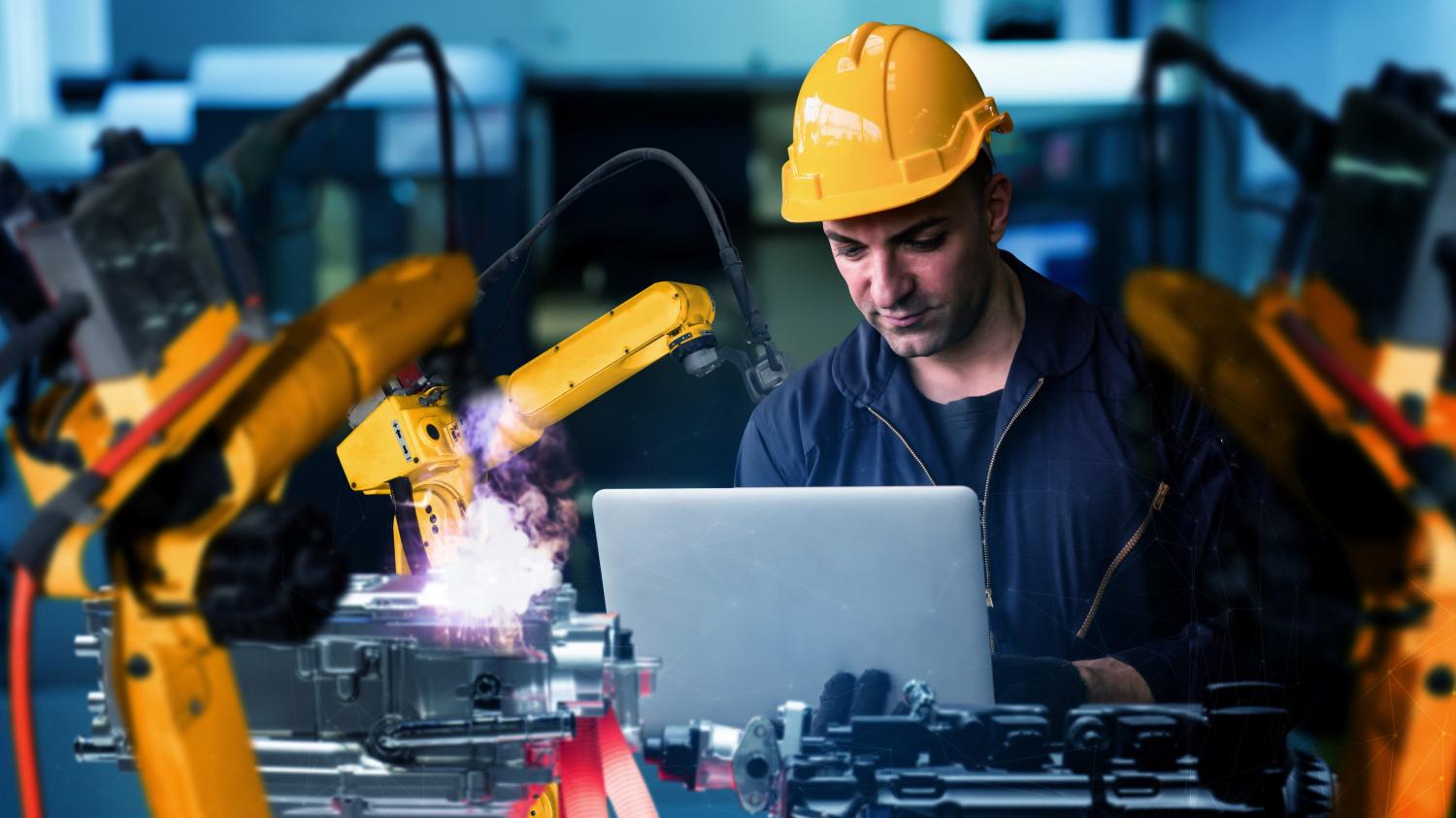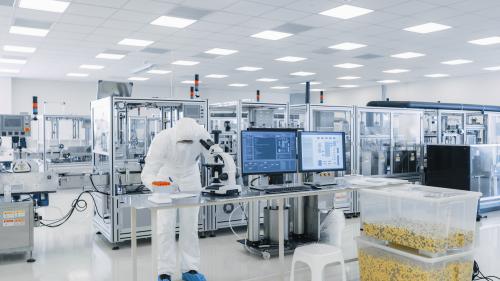This is a Brookings Center on Regulation and Markets policy brief.
Recent technological progress is fundamentally changing working environments by connecting physical and digital spheres. Connecting both spheres is enabled by augmenting automation with digitalization such that technology conducts work processes in a self-contained and automatic manner. Examples of such technologies include cyber-physical and embedded systems, smart factories, big data analytical tools, artificial intelligence (AI), and augmented reality (AR). Such cutting-edge technologies can perform work automatically and autonomously without human intervention, prompting fears of massive employment losses. Theoretically, the link between new technologies and employment is ambiguous. While most theories suggest that employment will grow on net, there is likely heterogeneity across workers, firms, and sectors of the economy (Agrawal et al., 2019; Barbieri et al., 2020).1 2 A growing literature has empirically investigated these issues mainly based on aggregate data for the economy and in specific industry sectors, but analyses at the level of firms and individual workers are rare (see the survey by Furman and Seamans, 2019).3 One likely reason for this gap in the literature is the scarcity of datasets that provide measures of the usage of advanced technologies at the firm level and accompanying workers’ outcomes. Such data are important to understand how these new technologies affect workers and firms.
Two German research institutes created a novel linked employer-employee dataset covering all industries in Germany to study the labor market consequences of the latest digital technologies, including AI and smart factories. The evidence from this new dataset suggests that the gains from firms’ technology adoption are split unevenly across different worker groups. Additionally, it indicates the rising importance of career and occupational changes and the ability to move across multiple employers. Data like this will deepen our understanding of the nuanced relationship between cutting-edge technologies and jobs, helping policymakers develop appropriate policy responses to ensure that workers keep pace with the latest technological progress. In the following, I will summarize the existing theoretical considerations and the empirical evidence on new technologies and jobs, highlighting new insights from the novel German data and suggesting appropriate policy recommendations.
The ambiguous effect of automation on employment
From a theoretical perspective, the net effect of the introduction of advanced technologies is ambiguous. On the one hand, economic theory predicts a negative displacement effect of automation technologies as these technologies have the potential to take over work activities previously performed by human workers, thus reducing employment (e.g., Acemoglu and Restrepo, 2019).4 A typical example of the displacement effect is the introduction of industrial robots that substitute for machine operators. On the other hand, new technologies can be labor-enhancing through several channels. First, advanced technology may reduce firms’ production costs while enabling higher product customization levels and improving product quality. This potentially increases product demand, which may contribute to rising labor demand for other tasks at the firm or for upstream suppliers of inputs. The net result may be an increase in employment (e.g., Bessen, 2019).5 Smart factories are a suitable example for this channel: assembly lines are connected with customer preferences specified in an online store, allowing factories’ assembly machines to process personalized products while producing on a large scale. Second, rising digitalization creates jobs in newly emerging business areas. For example, the popularization of e-commerce has led to the emergence of the business model of providing fulfillment services, i.e., a third-party that handles the logistics of e-commerce orders by storing, packing and shipping products. Third, automation and digitalization may create new work activities within existing jobs with a comparative advantage over technologies, fostering labor demand in non-automated tasks (e.g., Acemoglu and Restrepo, 2019).6 For example, rapid advances in computer programming have led web programmers to specialize increasingly in improving website usability. Thus, economic theory demonstrates multiple channels through which the latest technologies might affect labor demand but leaves the question about the net employment impact open.
Empirical evidence on employment effects of the adoption of new technologies
In the face of advancing automation, researchers have used the prevalence of industrial robots in the manufacturing sector to empirically measure the employment effects of technological progress. In Europe and several OECD countries, the estimated overall employment effect of robotization is neutral or broadly positive as declining employment in automating industries is offset by countervailing indirect effects such as reallocation of employment to other industries and rising aggregate demand (Graetz and Michaels, 2018; Autor and Salomons, 2018; Dauth et al., 2021).789 Conversely, Acemoglu and Restrepo (2020)10 find negative employment effects of industrial robot adoption across U.S. commuting zones. Recent studies increasingly focus on restructuring processes within and between firms, revealing reallocation of labor away from firms that do not adopt industrial robots towards adopting firms (Acemoglu et al., 2020; Koch et al., 2021).1112
Surprisingly little is known about the employment effects of cutting-edge digitalization and automation technologies beyond industrial robots. Using the routine intensity of occupations, which is the share of rule-based activities which computers are able to perform, as a proxy for technological change, studies document a decreasing employment rate of routine, middle-skilled employees while non-routine service jobs and professional and managerial occupations are growing (e.g., Cortes, 2016).13 Similarly, Harrigan et al. (2021)14 use the share of technology-related occupations within firms as a proxy for technology adoption since those workers play a central role in planning, installing, and maintaining modern technologies, as well as in training and assisting other workers in the use of technology. Bessen et al. (2019)15 use expenditures for third-party automation services as a firm-level measure of new technologies and show that Dutch workers are more likely to separate from automated than non-automated firms, especially incumbent workers who have already worked at the firm before the adoption event. By evaluating the potential of existing machine learning (ML) applications to conduct work activities of U.S. occupations, Brynjolfsson et al. (2018)16 hypothesize that ML might have a pervasive effect on employment across all sectors of the economy. However, the realized employment impact in the future will be uneven across occupations. It will depend strongly on the presence of specific work tasks that ML applications can take over and how these tasks will be reorganized in response to this new technology.
The existing empirical evidence draws a very nuanced relation between automation technologies and employment. On the one hand, displacement effects and increased turnover seem to cluster among workers directly exposed to automation. On the other hand, several studies point towards heterogeneous impacts across occupations. Therefore, to determine the employment effects of the latest advanced technologies, it is crucial to empirically examine the labor market consequences beyond industrial robots and across all industries. Looking at more aggregated levels might cover up opposing micro-level effects, and therefore researchers should investigate the individual-level impact of cutting-edge technologies as various types of workers might be differently affected.
Novel linked employer-employee data on the employment effects of new technologies
Two German research institutes—IAB and ZEW—developed a novel linked employer-employee dataset to study the labor market consequences of the latest digital technologies, including AI and smart factories, across all industries in Germany.17 The dataset combines an establishment-level survey on the adoption of new technologies with extensive individual-level data from the German Social Security Administration.
The establishment-level data stem from a representative establishment survey conducted in 2016. A single production plant is a typical example of an establishment in the manufacturing industries, whereas sales outlets represent establishments in the service industries. This disaggregated level of data allows for an analysis of the micro-level impact of technology adoption on the workers within specific establishments. In contrast, firm-level data might blur the adjustment margins as it is not possible to differentiate adopting and non-adopting establishments belonging to the same multi-establishment firm.
For the survey, the production or general manager was interviewed about the establishments’ degree of digitalization, and the questions covered (1) the relevance and perception of cutting-edge digital technologies, (2) the technology level of the entire work equipment, (3) changes in labor demand regarding skills and competencies, as well as (4) background characteristics including sales and profits.
The worker-level data stems from the social security records of the German Federal Employment Agency and covers the universe of German employees liable to social security contributions, benefit recipients, unemployed job seekers, and participants in active labor market policy measures. The data makes it possible to track the employment status of each person in the active labor force in Germany. For employed persons, the data contains comprehensive and accurate worker and job information, including workers’ education, occupational titles, and several measures of the tasks workers have to complete on the job, allowing researchers to study the individual-level impact of digital technologies across various types of workers.
Germany is a highly relevant country for studying the adoption of cutting-edge autonomous technologies given its long-term pioneering role in developing and applying innovative technologies. Previous research has demonstrated that Germany holds the highest number of automation patents in worldwide machinery (Dechezleprêtre et al., 2020)18 and the highest robot density in Europe, which is even three times higher than in the U.S. (Dauth et al., 2021; Graetz and Michaels, 2018).1920 The linked employer-employee dataset provides a novel means to measure the introduction of cutting-edge technologies beyond industrial robots at the establishment level and across all industries of the German economy.
What happens to workers when firms introduce new technologies?
Two recent studies based on the German linked employer-employee data do not support fears that cutting-edge technologies severely substitute for human labor (Genz et al., 2021; Genz and Schnabel, 2021).2122 Instead, they find that the average employment adjustments to the latest technologies, including AR and AI, are modest. However, the gains of firms’ adoption of technology are split unevenly across different worker groups.
Empirical evidence by Genz et al. (2021)23 suggests that IT workers across all industries in Germany experience the most substantial employment stability in firms that adopt cutting-edge digital technologies. Additionally, IT workers face a higher probability of entering adopting firms than non-adopting firms, confirming the crucial role of IT occupations for firm-level technology adoption.
Additional evidence related to new hires of adopting and non-adopting firms indicates that workers who conduct business services jobs, such as human resources development, customer management, or public relations, experience a higher probability of entering adopting than non-adopting firms. Hiring workers in these occupations might indicate that technology adopters generally expand their business or restructure their value chains in ways that require more workers (Genz et al., 2021).24
The nuanced impact of firms’ adoption of new technologies necessitates that policymakers take steps to prepare the workforce for the future.
Further empirical evidence by Genz et al. (2021)25 indicates that working with the latest technologies requires workers to conduct highly complex job activities. On the one hand, workers who conduct simple work tasks of low complexity experience lower employment stability at adopting firms than workers at non-adopters. On the other hand, expert workers whose responsibilities include highly complex tasks that require a very high standard of knowledge and abilities experience significantly higher employment stability at adopting compared to non-adopting firms.
Further evidence from a related paper by Genz and Schnabel (2021)26 suggests that technology adoption involves restructuring the occupational composition within adopting firms. Even workers in occupations that in the past were regarded as safe havens of employment, such as non-routine cognitive workers, experience increasing separation from the adopting employers that implement for the first time cutting-edge digital technologies. However, most separating non-routine cognitive workers take up jobs at other firms, such that differences in non-employment days between workers from adopting and non-adopting firms are small.
How can policymakers today shape the working world of tomorrow?
One of the main challenges for today’s policymakers is identifying the most significant impact of the latest technologies on the workforce and preparing individuals to obtain skills required in a work world with AI and AR, keeping their skills up to date and remaining employable in the long run. There is a unique opportunity for policymakers, educational institutions, training providers, industry, and academia to work closely together to find creative solutions to ensure that the workforce successfully keeps pace with technological progress. The nuanced impact of firms’ adoption of new technologies that split unevenly across different occupations and worker types necessitates that policymakers take steps to prepare the workforce for the future including encouraging enrollment in STEM (science, technology, engineering, and mathematics) subjects, promoting lifelong learning, facilitating occupational retraining, and generally working to reduce labor market frictions, as has already been initiated in several countries.
Encourage enrollment in STEM subjects
Technology adoption creates new jobs for IT-related occupations such as software developers, data analysts, cybersecurity managers, and others across all sectors of the economy. Consequently, labor market entrants must possess up-to-date skills that cutting-edge, technology-adopting firms demand. Therefore, as a prerequisite, education systems should strengthen STEM subjects and technological understanding. One example is Denmark’s Technology Pact to promote enrollment in STEM subjects and integrate IT skills in primary and lower-secondary education.27 In primary schools, new optional subjects in technological understanding have been introduced to bring children in touch with technology, and projects like the “Techie” children’s newspaper foster playful learning about science and technology. At Danish universities, several new machine learning and data science bachelor of science programs have been launched, and partnership agreements with elite American universities have been created to promote the exchange of Ph.D. students and researchers with experts at, for example, the Massachusetts Institute of Technology (MIT). Furthermore, additional funds have been allocated to support admissions for higher education in technical, digital, and natural science subjects to achieve higher enrollment in STEM subjects.
Support lifelong learning
The concept of converting early occupational aspirations into a single occupational choice that provides employment throughout one’s life no longer meets the labor market’s current requirements. Workers need to continue to learn after entering the labor market as, over time, the fast penetration rate of new technologies requires that workers’ skills evolve accordingly. Therefore, governments need to prepare and offer re-skilling programs at a larger scale. In Germany, the Federal Employment Agency has already acknowledged the need for lifelong career counseling and has offered professional reorientation and continuing professional development for the German population.28 Singapore’s government goes one step further and has created lifelong learning accounts which provide direct financial funding to upgrade existing skills or gain new ones over a worker’s lifetime.29 Ideally, education systems offer flexible solutions that facilitate skill upgrading within short time periods to meet current industry needs quickly, as has been pointed out by OECD’s Skill Strategy.30
Such a rapidly evolving labor market characterized by frequent career changes among workers will require workers to remain flexible, mentally resilient, and be prepared to move in and out of the labor market. The government should support transitions between employment and non-employment periods with adequate social security policies. For example, distributing relocation allowances to unemployed job seekers would incentivize employment in different regions or introducing “individual activity accounts” as has been done in France and Germany would link accumulated benefit entitlements to individuals rather than employment relationships.31
Government-funded retraining programs
Closely related to lifelong learning are retraining programs that offer a solution for motivated employees and job seekers who do not have the knowledge or the proper education to perform jobs that gain importance with the adoption of new technologies. Government-funded retraining programs may support career changes to remain employable. One example is the large retraining scheme “NL leert door – The Netherlands keeps on learning” founded by the Dutch government.32 Anyone with ties to the Dutch labor market and over eighteen years old can participate for free in retraining programs or online training programs ranging from a week to several months. A particular emphasis lies in acquiring digital skills such as programming, software development, cybersecurity, and the design and development of blockchain applications. Another example is Germany’s active labor market policy that includes a long-term retraining program for unemployed job seekers.33 The German government provides extensive two- to three-year vocational training to eligible, low-qualified unemployed individuals in order to enhance their job-finding probabilities. By increasing public spending on labor force retraining, policymakers can help smooth occupation switching in the workforce.
Targeting displaced workers
The adoption of digital technologies does not happen evenly across industries and occupations. Some countries acknowledge the burden for particular types of workers who are most at risk of being laid off as automation advances. For example, the Australian government introduced the “Automotive Industry Structural Adjustment Programme” to support blue collar workers who have been affected by plant closures of Australia’s car manufacturing industry.34 The government supports affected job seekers in the job application process by offering job interview training, job retraining opportunities, and by checking application documents. This tailor-made support acknowledges the existing skill set of workers in the manufacturing industry and tries to smooth the transition to other jobs with a comparable degree of complexity in industries less prone to automation. The Australian government thereby provides specific assistance to workers directly affected by introducing automation technologies to ease worker transitions.
Reducing labor market search frictions
One obvious yet often overlooked implication of rising AI applications across all industries is integrating cutting-edge technologies and services into labor market platforms. Individuals should quickly obtain information regarding the latest high-quality skill updates and providers of such services. Furthermore, employment agencies should work efficiently, for example, by providing and autonomously updating digital platforms and posting online job positions for employment seekers. For example, the Flemish public employment service VDAB has launched a digital platform that offers job seekers an orientation test that automatically provides personalized job suggestions and training programs using AI and ML.35 This is one example of how applying the latest technological innovations might reduce search frictions in labor markets.
Conclusions
The relationship between new technologies and jobs is complex, as rapidly spreading, cutting-edge technologies such as AI and AR lead to uneven impacts across workers. Recent research suggests that career changes, switching occupations, and moving across multiple employers and even across industries will increasingly become important for workers to remain employed. Policymakers should invest in measuring how these new technologies are adopted and used in firms to facilitate future research on the drivers of nuanced adjustments across different workers.36 It is equally important for policymakers to invest in labor market policies that help individuals prepare for the changing demands of work environments of the future.
-
Footnotes
- Agrawal, A., Gans, J. S., Goldfarb, A., 2019. Artificial Intelligence: The Ambiguous Labor Market Impact of Automating Prediction. Journal of Economic Perspectives 33(2): 31-50. https:doi.org/10.1257/jep.33.2.31.
- Barbieri, L., Mussida, C., Piva, M., Vivarelli, M., 2020. Testing the Employment and Skill Impact of New Technologies. In: K. F. Zimmerman (ed.), Handbook of Labor, Human Resources and Population Economics, pp. 1-27, New York: Springer.
- Furman, J., Seamans, R., 2019. AI and the Economy. Innovation Policy and the Economy 19(1): 161-191. https://doi.org/10.1086/699936.
- Acemoglu, D., Restrepo, P., 2019. Artificial Intelligence, Automation and Work. In The Economics of Artificial Intelligence: An Agenda, pp. 197–236. National Bureau of Economic Research, Inc.
- Bessen, J. E., 2019. AI and Jobs: The Role of Demand. In The Economics of Artificial Intelligence: An Agenda, pp. 291–307. National Bureau of Economic Research, Inc.
- Acemoglu, D., Restrepo, P., 2019. Automation and New Tasks: How Technology Displaces and Reinstates Labor. Journal of Economic Perspectives 33(2): 3-30. https://doi.org/10.1257/jep.33.2.3.
- Graetz, G., Michaels, G., 2018. Robots at Work. Review of Economics and Statistics 100(5): 753-768.
- Autor, D. H., Salomons, A., 2018. Is Automation Labor-Displacing? Productivity Growth, Employment, and the Labor Share. Brookings Papers on Economic Activity, Vol. 2018 (1): 1-87. https://www.brookings.edu/wp-content/uploads/2018/03/AutorSalomons_Text.pdf.
- Dauth, W., Findeisen, S., Südekum, J., Wößner, N., 2021. Adjusting to Robots: Worker-Level Evidence. Journal of the European Economic Association, forthcoming. https://doi.org/10.1093/jeea/jvab012.
- Acemoglu, D., Restrepo, P., 2020. Robots and Jobs: Evidence from US Labor Markets. Journal of Political Economy 128(6): 2188-2244.
- Acemoglu, D., Lelarge, C., Restrepo, P., 2020. Competing with Robots: Firm-Level Evidence from France. AEA Papers and Proceedings 110: 383-88.
- Koch, M., Manuylov, I., Smolka, M., 2021. Robots and Firms. The Economic Journal 131(638): 2553-2584. https://doi.org/10.1093/ej/ueab009.
- Cortes, G. M., 2016. Where Have the Middle-Wage Workers Gone? A Study of Polarization Using Panel Data. Journal of Labor Economics 34(1): 63-105.
- Harrigan, J., Reshef, A., Toubal, F., 2021. The March of the Techies: Job Polarization Within and Between Firms. Research Policy 50(7): 104008.
- Bessen, J. E., Goos, M., Salomons, A., Van den Berge, W., 2019. Automatic Reaction – What Happens to Workers at Firms that Automate? Boston Univ. School of Law, Law and Economics Research Paper No. 19-2. https://scholarship.law.bu.edu/faculty_scholarship/584.
- Brynjolfsson, E., Mitchell, T., Rock, D., 2018. What Can Machines Learn, and What Does It Mean for Occupations and the Economy? AEA Papers and Proceedings 108: 43-47.
- The questionnaire of the establishment survey is available online and information about accessing the data is provided by the Research Data Center of the German Federal Employment Agency (see https://fdz.iab.de/en/FDZ_Establishment_Data/BIZA/BIZA_W01.aspx).
- Dechezleprêtre, A., Hémous, D., Olsen, M., Zanella, C., 2020. Automating Labor: Evidence from Firm-level Patent Data. CEP Discussion Paper No. 1679. https://cep.lse.ac.uk/pubs/download/dp1679.pdf.
- Dauth, W., Findeisen, S., Südekum, J., Wößner, N., 2021. Adjusting to Robots: Worker-Level Evidence. Journal of the European Economic Association, forthcoming. https://doi.org/10.1093/jeea/jvab012.
- Graetz, G., Michaels, G., 2018. Robots at Work. Review of Economics and Statistics 100(5): 753-768.
- Genz, S., Gregory, T., Janser, M., Lehmer, F., Matthes, B., 2021. How Do Workers Adjust When Firms Adopt New Technologies? IZA Discussion Paper No. 14626. https://ftp.iza.org/dp14626.pdf.
- Genz, S., Schnabel, C., 2021, Digging into the Digital Divide: Workers’ Exposure to Digitalization and its Consequences for Individual Employment. IZA Discussion Paper No. 14649. https://docs.iza.org/dp14649.pdf.
- Genz, S., Gregory, T., Janser, M., Lehmer, F., Matthes, B., 2021. How Do Workers Adjust When Firms Adopt New Technologies? IZA Discussion Paper No. 14626. https://ftp.iza.org/dp14626.pdf.
- Ibid.
- Ibid.
- Genz, S., Schnabel, C., 2021, Digging into the Digital Divide: Workers’ Exposure to Digitalization and its Consequences for Individual Employment. IZA Discussion Paper No. 14649. https://docs.iza.org/dp14649.pdf.
- Strategy for Denmark’s Digital Growth, The Danish Government, 2018. https://eng.em.dk/media/10551/digital-growth-strategy-report_uk_web.pdf.
- National Skills Strategy, Federal Ministry of Labour and Social Affairs of Germany, June 2021. https://www.bmas.de/SharedDocs/Downloads/DE/Publikationen/a805e-implementation-report-national-skills-strategy.pdf?__blob=publicationFile&v=2.
- About Skillsfuture, Skillsfuture, Accessed May 3, 2022. https://www.skillsfuture.gov.sg/AboutSkillsFuture.
- OECD Skills Strategy 2019, OECD, May 22, 2019. https://doi.org/10.1787/9789264313835-en.
- Going Digital, OECD, Accessed May 3, 2022. https://www.oecd.org/going-digital/changing-nature-of-work-in-the-digital-era.pdf.
- Support scheme NL leert door (NL keeps on learning), Netherlands Enterprise Agency, RVO, Accessed May 3, 2022. https://business.gov.nl/subsidy/temporary-support-scheme-nl-leert-door-nl-keeps-learning/.
- Grunau, P., Lange, J., 2020. Retraining for the unemployed and the quality of the job match. Applied Economics 52(47): 5098-5114. https://doi.org/10.1080/00036846.2020.1753879.
- Helping redundant automotive workers find new employment, Australian Government, February 25, 2022. https://business.gov.au/grants-and-programs/automotive-industry-structural-adjustment-programme.
- VDAB trekt digitale kaart om mensen aan een job te helpen, Public Employment Service of Flanders, VDAB, October 5, 2018. https://www.vdab.be/nieuws/pers/vdab-trekt-digitale-kaart-om-mensen-aan-een-job-te-helpen.
- Seamans, R. “Robot census: Gathering data to improve policymaking on new technologies.” The Brookings Institution, February 2, 2022. https://www.brookings.edu/research/robot-census-gathering-data-to-improve-policymaking-on-new-technologies/.







